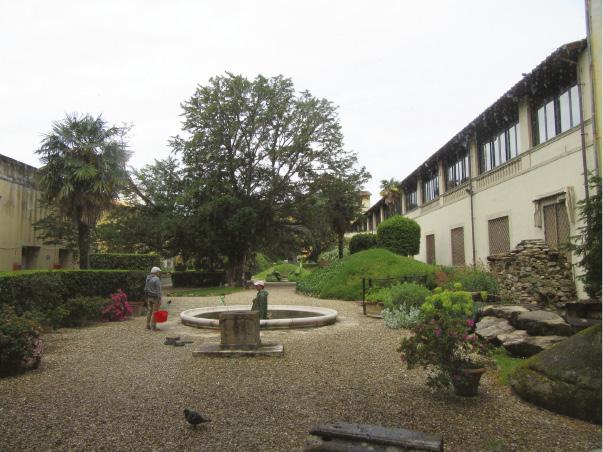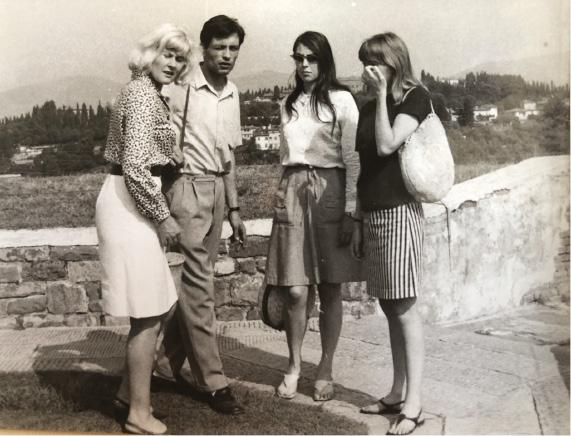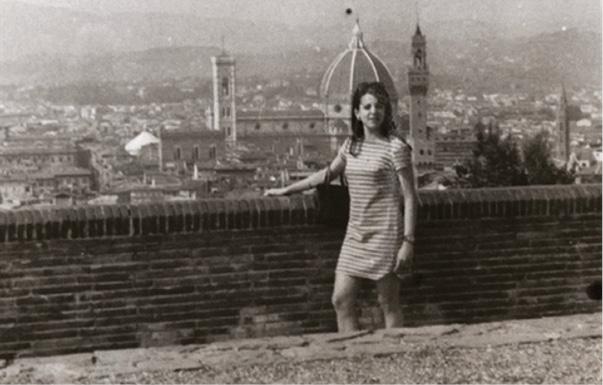Foreword
This article is about a ‘forgotten’ part of Institute history. I became involved in its recording by chance. On 21 May 2019 Judith Toms gave a talk in the Accordia series of lectures on Italy about her research on the archaeology and history of the Etruscan site of Tarquinia. She mentioned in passing that she had come across a number of letters in the archives of the Florence Archaeological Museum referring to the involvement of Institute conservation students in rescue work at the Museum after the devastating flood of November 1966. In spite of my own involvement in Italian archaeology and my long familiarity with the Institute of Archaeology, I had never heard of the participation of Institute students in the rescue effort in Florence. It turned out that nobody else had either, at least nobody still at the Institute, and I was unable to locate any archival material in the Institute relating to this event. Retired Professor and former Head of Conservation at the Institute Liz Pye had no relevant memories herself, but she gave me the names of some conservation students who were around at the time, who might have some relevant knowledge. One of these was Louise Bacon – who turned out to be one of the conservators involved. I was struck by the interest of the whole story and how nearly it had disappeared from memory. I thus suggested to Louise that she and her colleagues might write about it for Archaeology International, a suggestion they took up with enthusiasm.
The correspondence from the 1960s that I have seen is extremely partial. It consists of a group of letters dated November and December 1966, which corresponds to the weeks immediately after the flood, and then three letters from May and June 1968. The 1966 letters represent correspondence between the Soprintendenza in Florence (in the person of Guglielmo Maetzke), and (1) Brian Shefton, of the University of Newcastle; (2) John Ward-Perkins, Director of the British School at Rome; and (3) H.E. Werner of the British Museum Research Laboratory. All three offer help in dealing with the flood damage, Werner on behalf of the British Museum Research Laboratory and both Shefton and Ward-Perkins on behalf of the Institute of Archaeology (both make clear that they had been in touch with Professor Grimes, Director of the Institute, and were acting as intermediaries). All these letters refer to bronze artefacts rather than pottery.
The May 1968 letters are between Grimes and Maetzke and discuss the arrangements for the visit of four conservators from the Institute to Florence. There is not much information about the practical arrangements, although in one letter Grimes refers to the Italian Art and Archives Research Fund and another to the British Consul in Florence.
It is possible that further archival research might unearth more correspondence, but any details to emerge are likely to be much less interesting than the direct memories of the participants – which follow here.
Ruth D. Whitehouse
Professor Emeritus
UCL Institute of Archaeology
On 4 November 1966 heavy rains in the upper Arno Valley swelled the river and, sweeping all before, it plunged towards the city of Florence. There had been floods before, but this time the darkish brown water carried different materials; oils and other toxic chemicals. The Arno overflowed its banks, bursting through doors and flooding homes, churches and museums. Electric power was cut off, leaving residents to listen to the churning water and wonder what tomorrow would reveal. Sadly, many museums discovered severely damaged or lost treasures. Florence, the City of the Renaissance, sent out a plea for help. The world answered that call by sending monetary relief. Conservators from many countries arrived to assist with the cleaning of priceless paintings, bronzes and statuary.
The heart and soul of the Conservation department of the Institute of Archaeology, and of the taught Diploma in Archaeological Conservation at the time, was Miss Ione Geyde, a pioneer in objects conservation. When the British effort was organised, Professor Grimes, Director of the Institute must have contacted her to ask her to select suitable conservation students for the programme, although no correspondence to this effect survives.
On Monday 8 July 1968 three newly qualified object conservators, Louise Bacon, Jo Rutter (who passed away in 2009) and Christina Haywood (née Souyouldzoglou) met at Victoria station and boarded the night train to Florence. Marion Moir (née Bacon), a student in her first year, drove to Italy in her MG Midget. Our six-week mission was to help with the continuing conservation work of flood-damaged archaeological artefacts. We arrived in Florence on the Tuesday. We had been booked into comfortable rooms in the Pensione Alessandra, in the narrow, typically Florentine via SS Apostoli, where we would be provided with breakfast and an evening meal for the length of our stay.
The following day we went straight to the National Archaeology Museum (Museo Archeologico Nazionale di Firenze), located in an old Medici Palace (Palazzo degli Innocenti) (Cianferoni et al. 2013, 357 ff), with a lovely luxuriant garden on one side (Figure 1). The Conservation Laboratory of the Archaeological Superintendency of Tuscany (Centro di Restauro della Soprintendenza della Toscana) was accommodated in the same building, with a rear entrance for staff and access to the offices. A main staircase led to the laboratory located on an upper level. The Laboratory was founded in 1967, directly after the flood, thanks to the efforts of the Superintendent of Antiquities in Etruria, Guglielmo Maetzke. He entrusted the task of making it a reality to two archaeologists of the Superintendency, Francesco Nicosia and Mauro Cristofani (Lo Schiavo et al. 2010; Bettini and Poggesi 2013, 1–2). Its purpose was to treat the c.200,000 flood-damaged archaeological artefacts, as well as finds from new excavations in the area. Upon our arrival in the Laboratory, we were introduced to the Museum’s conservators, mostly freelance or temporary staff among whom were artists and sculptors, and to the laboratory supervisor and designated ‘mentor’ of our group, Giorgio Tolone.

The garden of the Museo Archeologico Nazionale di Firenze, with Marion Moir (2018). (Image credit: Louise Bacon)
Work proper started on Thursday. The Laboratory occupied a large, open-plan space. The four of us were placed in a separate area; we were not close but could still see each other. On our arrival there was another foreign conservator there, Lisa Mibach, an American, who also worked on flood-damaged material. The premises had long curtains/roll-down blinds to cut out the strong summer sun, but given the lack of air conditioning the room tended to get very warm and stuffy. Those of us not used to hot climates found this difficult and recall feeling faint and being ‘revived’ with alcohol wiped across the back of our necks!
We were introduced to Italian working hours, with a long lunch break, which created an initial upheaval as the hours were somewhat different from what we expected, based on British working schedules. But, after the mediation of our more senior colleague and Italian speaker, Jo, the matter was quickly settled. We were paid for our work – we collected our money every Thursday from the British Consulate. Our records mention a weekly stipend of 23,000 Italian Lire (the approximate equivalent of £15 at the time).
Somewhat to our surprise, the artefacts that we were assigned to work on were ceramics, not metals as Ione Geyde was obviously informed (which also matches the mentions in the correspondence referred to by Prof. Whitehouse in her preamble). For this reason, we had arrived armed with the appropriate tools for metals (including electric vibrotools, the essential tool for cleaning corroded metals) and with the chemical Benzotriazole, the revolutionary product in 1968 for the stabilisation of bronzes. In hindsight, the change in our role may have been due to some internal museum matters. The department for the conservation of metals occupied a separate floor to that of the conservation of ceramics. As far as we can remember, we never visited the former department or were even aware of it! However, we had also carried with us a jar of AJK (Alvar, Jute, Kaolin) dough, which we used at the Institute as a standard for restoring ceramics. But our expertise with the material was not of great use as it turned out. Louise did a trial, as the Italian colleagues were very interested, but the material quickly proved unsuitable for the Italian climate; being solvent-activated, it kept drying out too quickly and shrinking.
Methods and materials were still at an experimental stage at the time. Our Italian colleagues introduced us to a new-to-us material in conservation, an ‘easy-to-use’ gap filler called DAS (Dasso). DAS was an air-hardening modelling clay that came in powder form, was mixed with water to form a dough and had pigments added to produce different hues. Undoubtedly it matched well the fabrics and shades of the Greek and Etruscan pots that were being restored. The material had been introduced as an alternative to plaster of Paris, the idea being that it was softer than the ceramics, so if some other disaster was to happen, the restoration rather than the pot itself would break – the latter fate being what happened to pots restored with plaster of Paris at the time of the flood. We really never got the hang of it. Eventually DAS proved to be too weak to support severely fragmented pots. Christina, who followed up the developments after we left, learned that its use at the Florence Laboratory was discontinued (although DAS was still used in conservation later in its alternative form as a readymade dough).
We were never really given a choice of pots; pottery would appear on a table and they were ours to clean and repair. As she was still a student, Marion kept her conservation work sheets for London; they recorded the materials and methods of treatment used, and several are still in her possession. Of interest is the record of swabbing the pottery in a solution of hydrochloric acid to remove calcareous incrustations – a general practice in the Mediterranean, but one that to us must have seemed strange! But there was also interest among the staff in the conservation methods that we used at the Institute, and the two archaeologists in charge personally discussed treatments with us, as well as giving us instructions and advice.
A very genuine friendship developed between our small team and the freelance conservation staff of the Museo Archeologico. We were taken for lunch to local restaurants away from the tourist track, including an upland lakeside fish restaurant not far from the small Tuscan town of Vicchio; here, if you so wished, you could catch your own fish. In the vicinity, we spent some time at the important Etruscan site of Poggio di Colla, in its first year of excavation by Francesco Nicosia. In Florence we were shown around city beauty spots and heritage sites, including the Forte di Belvedere (Figures 2 and 3), Palazzo Pitti and the hill of Fiesole. In the city itself, evidence of the flood was everywhere we walked, from marks on the walls showing the height of the water to houses propped up with timbers. Particularly memorable was the visit by some of us to the church of Santa Croce where the Cimabue cross was still lying face down in pieces in the mud and debris of the flood. There was much discussion at the time as to how to approach its conservation, whether to restore totally or just save what they could. Christina was back in Florence with her husband in 1976–7 when, ten years after the flood, the restored cross was put back on public display, and she attended seminars where the challenges and often acrimonious debates about the methodology to be used were all too evident. In 1983 the cross was on display at the Royal Academy in London, fully conserved and its paint layer partially restored in the nuanced way (technically defined as ‘colour abstraction’) that had been finally decided upon. Left to our own devices, in addition to shopping sprees in the local markets – the famous Mercato di San Lorenzo in particular, we visited all the museums and art galleries in the city, having been issued with free museum entrance passes. We also went to Rome where we watched a performance of Aida in the Baths of Caracalla, and we visited Pisa, Lucca, Ravenna and Venice. A highlight towards the end of our stay was our excursion to Siena for the Il Palio horse race on 16 August, when most of the staff of the Laboratory also attended. Despite all these distractions, we felt at the time that we had made a contribution, albeit small, towards the Florence flood effort. What we did not realise then was how profound and long-lasting an impression the experiences of this short spell in our lives would have.

At Forte di Belvedere in 1968. From left to right: Jo Rutter, Giorgio Tolone, Marion Bacon and Louise Bacon. (Image credit: Christina Souyoudzoglou-Haywood)

Christina Souyouldzoglou, at Forte di Belvedere, with Florence in the background in 1968. (Source: Christina Souyoudzoglou-Haywood)
In May 2018 Marion and Louise made a sentimental journey to Florence – 50 years after we had been there, this time travelling by air; no need for seats made into benches on a night train! The Archaeology Museum, which in 1968 was closed to the public, now had a full display, and they walked around the bucchero pots fancying that they were the ones they had worked on. They were fortunate to get an impromptu meeting with the Museum’s Director, Mario Iozzo, who was generous with information about the Laboratory, both then and when he was later contacted by us. From him we learned about the developments that followed our 1968 stint at the Laboratory.
The Laboratory had grown in size in the following years. In 1972 the Centre for Conservation of the Archaeological Superintendency of Tuscany (Centro di Restauro della Soprintendenza della Toscana) was formerly founded. It was housed in a building in Via del Palazzo Bruciato. The three sections that were previously in the Archaeology Museum (the ceramics section where we worked, plus the metals and photographic sections) were moved there, and all previously temporary staff were made permanent. New sections were added in due course (X-ray, chemical and biological analyses, drawing, etc.). From that time on, the Centre continued to grow in size, and in 1984 it moved to a much larger building. When Dr Iozzo became its Vice-Director (1996) and later Director, the Centre numbered 47 conservators, as well as chemists, biologists, draftsmen, architects and photographers. It became a flagship conservation establishment with an international reputation and had undertaken the conservation of masterpieces such as the Riace ‘warrior’ bronze statues. Unfortunately, the end of the story is not a happy one. In recent years there had been a decline in staff, due to the lack of reappointments, and the decision was taken to close the Centre down, which took effect in December 2018. The Centre was dismantled, and all the artefacts housed inside (vases, bronzes, terracotta and stone pediments, Etruscan grave furniture, coins, jewellery, marble statues and all the most delicate and precious finds) were hastily packed and returned to the Museums that had sent them to the Centre for conservation (M. Iozzo, personal communication 2020; Iozzo 2018, 35, note 4).
Sadly, Louise and Marion’s visit to Florence on our 50th anniversary coincided with the year of the closure of the Centre, after 50 years in operation. It is hard to believe that a decision was taken to close this important institution. The authors are thankful to the Institute of Archaeology for the opportunity that was offered to them to contribute to the Florence flood effort, and to play a tiny part in the history of the Florence Centro di Restauro.

